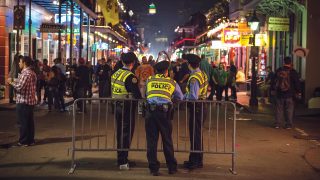

Violence can be blinding, and a badge doesn’t change the effect. Occasional inconsistent training for confrontation does not adequately prepare a person to manage emotions and employ effective self-defense tactics in the midst of a high-stress physical altercation. This is something that is commonly understood by experienced martial artists, some of whom are police and service officers.
After recent viral videos showing officers using excessive force, or, in the case of George Floyd, lethal force resulting in death, the question is again being asked: Why do some police officers resort to lethal force when other options are available, particularly when facing an unarmed citizen? Some instances are inexcusable and seemingly a product of ego or racism; others may be the unfortunate byproduct of inadequate training. Some jiu-jitsu practitioners believe they can offer an answer to one facet of this complex problem.
Iako Kalili is a former Army Combatives instructor who holds a Brazilian jiu-jitsu black belt and currently works as a VIP bodyguard, standing watch for the likes of Five Finger Death Punch and Billie Eilish. He has spent a lifetime learning martial arts and teaching others, but more importantly he has actually applied the things he’s learned in dangerous, high-stress altercations. Those valuable lessons helped him improve his own training and coaching, and he wants to share that knowledge with police. He’s been in talks with the Highlands Ranch Law Enforcement Training Facility in hopes of introducing a new curriculum that he believes could improve safety for police and citizens across the state of Colorado.
Kalili began practicing Brazilian jiu-jitsu a couple of years before deploying with the Army to Iraq. “My unit was in charge of the highways that ran between Fallujah and the Abu Ghraib prison. We did a lot of raids where we’d often capture people of interest,” Kalili said.
That’s where he first gained insight into what soldiers experience on the ground, insight he could later use in his training of others. It also helped him realize he needed to learn more. There had to be a substitute for a muzzle thump or punch in the face when a situation called for it, like when he was capturing a religious community leader. Coincidentally, General Stanley McChrystal had a similar realization around the same time. In the late ’90s, the general launched the development of the Army Combatives Program, a specialized martial arts program that relies heavily on jiu-jitsu and is designed specifically to train soldiers with the skills they’d need in the field, and Kalili became heavily involved in curriculum design and teaching.

A revelation struck Kalili when he was teaching Green Berets in the Special Forces Advanced Urban Combat Course at Fort Carson. Even during training, Green Berets were using highly violent techniques to pacify their training partners because they hadn’t yet trained enough to have other tools.
“Their job is to go into buildings and shoot people who needed to be shot and detain people who need to be detained,” Kalili explained. “Does the guy have a gun? Is he aiming at me? Does he need to be shot? Does he need to be detained? This is where I developed a sense of ‘we can’t just go in there and shoot everybody.’ There are going to be people in there who can’t be shot.”
Unfortunately, the training partners were the base cooks. As the carnage continued, the chow hall ran low on staff. The immediate problem was lunch but the ultimate problem was performing intelligently in the field. “We can’t just beat up a sheik,” Kalili said.

In the world of policing, all citizens should be treated as sheiks until they prove to be combatants, and even then, escalation of force should only match the combatant’s use of force. Lethal force is the last resort on the use-of-force continuum, but like the Green Berets, police officers can only use the tools they’re given. In the absence of substantive martial arts training, police may resort to needlessly violent techniques or lethal force.
For a Green Beret, lethal force always requires an explanation. “Being scared is not an option,” Kalili said. But for police, fear seems to be a regular part of the conversation.
Not all police are scared or underprepared, though. Many of them know very well the benefits of martial arts training — Special Deputy U.S. Marshal and Investigator Mike Jones among them. An eight-year veteran of law enforcement currently serving in northern Colorado, Jones is also a blue belt in Brazilian jiu-jitsu and is passionate about sharing the benefits of martial arts with other law enforcement officers.
Like Kalili, Jones began his career in the military, serving as a military police officer in the Air Force. He was exposed to martial arts in the Combatives Program and decided to continue his training when he became a cop so he could effectively control people. He estimates he’s been in 20 to 30 fights in his career, but in those altercations, he’s never used a baton or pepper spray and has only deployed a stun gun once. One of those fights in particular could have ended very differently.
On a highway in middle-of-nowhere Colorado, Jones responded to a call about a suicidal young man who turned out to be a collegiate-level wrestler. Jones was alone, and it was apparent that the man was in a mental-health crisis. After talking to Jones for a few minutes, the man tried to throw himself in front of an oncoming semi-truck. Jones took him to the ground before he could take his own life.

Jones quickly found himself in a wrestling match with an able opponent. Jones believes that if someone else had responded to the call, that situation could have ended with lethal force, and the other officer may have been justified. Luckily, Jones had not only the skills to protect himself but also the presence of mind that comes with consistent martial arts training. His few years of dedicated grappling helped him understand exactly what was happening in the moment. He felt and understood the movements of the man in a way that only an experienced grappler can.
“It was one of those moments where I thought, ‘I’ve been here before,’ so I’m not freaking out. His movement on the ground was not to advance position and hurt me, it was to get up and get away, which is a lot of the resistance we run into on the ground, just people trying to get away from us,” Jones said.
In a stressful situation, Jones knew he was dealing with someone who didn’t need to die or even get stunned. A similar mindset is difficult to attain with the minimal training provided to police in the academy, which in Colorado amounts to about 62 hours to start and up to 16 hours per year in refresher courses. As we discuss how to fund and train police, we should not overlook that martial arts training, specifically jiu-jitsu, could save the lives of both officers and civilians. Experienced peace officers and soldiers know that martial arts training can provide the physical capabilities and mental awareness to dramatically change outcomes when police interact with civilians
“I hope agencies get on the train of getting their guys jiu-jitsu training. But I’ve said this to every cop I run into, when you started doing this job, you might have to train on your own time and your dime,” Jones said.
As seen in the March 2021 issue of American Police Beat magazine.
Don’t miss out on another issue today! Click below:





